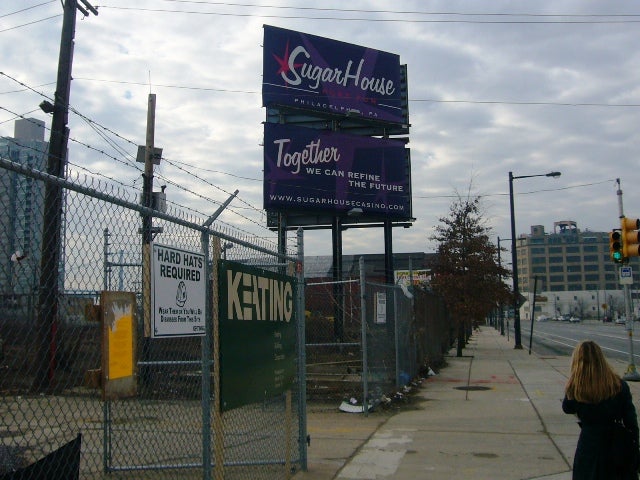Update: SugarHouse permit process flap

Jan. 07, 2008
Click here for link to relevent state and federal historic protection acts.
Phase I archaeological report
Phase II archaeological report
By Kellie Patrick Gates
For PlanPhilly
SugarHouse Casino on Monday began the earliest stages of construction — moving dirt in order to prepare the Delaware Riverfront site for building.
Anti-casino activists and elected officials who want the casinos built elsewhere collectively shrugged, saying such preliminary site work doesn’t amount to much more than appeasing the casino’s investors. CasinoFree Philadelphia co-founder Daniel Hunter didn’t even bother to call out the troops who’ve practiced civil disobedience to stop casino construction. “It isn’t even that important,” he said.
But the dirt and its potential contents are precious to a group of local historians and history buffs. They worry artifacts left behind by British and loyalist soldiers during the Revolution and by the Lenni-Lenape Indians before that will be destroyed before they are discovered.
“That’s what I think they’re hoping for – to destroy what might be there,” said Hilary Regan, a consulting party to the ongoing archaeological review process on the SugarHouse site, who frantically made cell phone calls to state and local agencies as she watched the heavy equipment at work. SugarHouse officials have said they believe there is little archeological significance left on the site, after many years of industrial use.
Three city Licensing and Inspections representatives were also walking the site Monday with permits in hand, making calls in response to Regan’s questions to try to determine where the authority to allow the work lies.
Both the historians and the no-casino-here crowd question why permits allowing the work were issued prior to the conclusion of the historic review.
The City of Philadelphia issued the rough grading permit Friday – the last day of the pro-casino Street administration.
SugarHouse spokeswoman Leigh Whitaker has said the timing is coincidental. On Dec. 31, the Pennsylvania Supreme Court declined a City Council request to re-examine the court’s decision that SugarHouse should have the Commercial Entertainment District zoning it needs for the casino. The city made that official by issuing the zoning permit, and then followed with the rough grading permit, Whitaker said.
But many found the timing suspicious. Councilman Frank DiCicco, who wants the casinos built elsewhere, asked new mayor Michael Nutter to do something, said his spokesman, Brian Abernathy. So did some anti-Casino and pro-history activists. Nutter spokesman Doug Oliver said Tuesday morning that Nutter has asked new Licenses and Inspections Commissioner John Elfrey to make sure the permit was issued properly.
“The decision to grant the permit – was it expedited, or was it the normal process? We don’t know,” Oliver said.
He did not know when the review would be complete, but suspected it would not take long.
Friday was also when the Pennsylvania Department of Environmental Protection gave SugarHouse its National Pollutant Discharge Elimination System Permit, commonly known as the NPDES.
The NPDES is the prerequisite of the grading permit. Usually, several other permits are issued prior to the NPDES, but at SugarHouse’s request, that was not the case here.
In most cases, an NPDES applicant would first have to have an approved sewage plan and a construction permit for a combined (storm water and waste water) system from the city, and a Water Obstruction and Encroachment Permit, which is a joint permit filed with both the DEP and the Army Corps of Engineers, said Department of Environmental Protection spokeswoman Deborah Fries.
It is the Water Obstruction and Encroachment Permit that requires the archaeological review. A federal regulation requires the Army Corps to examine the history of an area and make efforts to preserve anything important that might be on a site before issuing the permit. In this state, it does so with the assistance of the Pennsylvania Historical and Museum Commission.
The first meeting of SugarHouse, the Corps, the Historical and Museum Commission, and a group of interested consulting parties, including Regan, is scheduled for Jan. 18.
But the order in which the Department of Environmental Protection issues permits is a Department policy, not a regulation, Fries said, and so it can be changed. When asked for other examples of variation, both she and Southeast Assistant Regional Director John Kennedy could only list one example, the Worthington Steel redevelopment project in Delaware County. Kennedy said he was not certain that project lacked the Water Obstruction permit.
When asked why the Department decided to change the permit order for SugarHouse, Kennedy said: “because we felt that – let’s face it, this is a pretty large, controversial project. What this does is this gives them a little bit of wiggle room to get some earth moving done.”
That infuriated Regan.
“They should not be concerned with getting this project done, they should be concerned with environmental protection,” she said.
A man at the top of state government – Gov. Ed Rendell – is very much concerned that the casino gets built. He’s planning on using some of the gambling revenue to lower taxes.
But “the Governor had no role at all in determining the issuance of the permit,” said Rendell spokesman Chuck Ardo.
Kennedy said the changing of the mayoral guard played no role, either. “The timing is not good, obviously, given the fact that it was the tail end of the Street Administration, and a new mayor was sworn in today. I understand the concerns that it was done at the last minute just to do it, but that is not necessarily the case. We were able to approve it, it was technically sound, so there was no sense sitting on it.”
The cover letter that DEP Regional Manager James Newbold sent to SugarHouse along with its permit states “you are also cautioned not to disturb areas that may be subject to historic investigation by the Pennsylvania Historic and Museum Commission or the federal ‘Section 106’ historic investigation being undertaken pursuant to the permit application pending before the U.S. Army Corps of Engineers.”
Proceeding is “a risk to the applicant,” Kennedy said and it is SugarHouse’s responsibility not to dig more than they should. “If other permits are not approved they could be in hot water.”
SugarHouse spokeswoman Whitaker said the DEP cover letter’s warning is typical of permits. “It’s like their disclaimer,” she said. “If something happens, if we strike a piece of the ground not covered by the permit, we can’t go back to them and say, ‘Well, you gave us this permit.'”
Pennsylvania Historical and Museum Commission spokesman Kirk Wilson said the Commission would not discuss its position on the SugarHouse site, which it is expected to state at the Jan. 18 meeting. “The information we’re responsible for should be released by the Corps, as they are the lead agency,” he said.
The PHMC would also not monitor the digging happening on the site to make sure no history is harmed. “We put the responsibility of doing that in proper fashion with the Army Corps,” he said.
An email sent to the Army Corps by Terry McKenna, project executive for SugarHouse’s general contractor, Keating Consulting, said “it is recognized that if we proceed, we are proceeding at risk, and we cannot perform any work that would impact waters on the site. Finally, we recognize that we cannot impact the 106 areas of concern.”
PlanPhilly saw the email because it became electronically attached to a copy of the two permits, which were being circulated to many interested parties.
McKenna was not available for comment today, but Whitaker said his words were meant to acknowledge that he had read the DEP’s “disclaimer.”
Regan said she was focusing her efforts on getting local elected officials involved in the situation.
Both the DEP permit and the city permit can be appealed.
“There’s nothing we can do,” DiCicco spokesman Abernathy said in an email late Monday afternoon, because it takes a vote of the entire City Council to take action, and Council doesn’t meet again until Jan. 24.
SugarHouse spokeswoman Whitaker has sounded upbeat lately. Things are moving forward, she said, and other permits are expected soon.
But the historians and other activists have not stopped looking for roadblocks.
The Philadelphia legislators whose districts touch the river filed an appeal of the Commerce Department’s decision to grant SugarHouse the right to build into the riverbed, saying only the General Assembly can grant riparian rights.
And an endangered turtle might be demanding some rights, too.
On Dec. 21, the Pennsylvania Fish and Boat Commission said in a letter to a SugarHouse engineering contractor that the red-bellied turtle has been known to inhabit the Delaware near the SugarHouse site, so steps must be taken to protect it.
The Commission says these turtles – one of the largest that live in the state – hibernate during the winter, so any work done in the water, with the exception of pile driving, should be done from May to October, so as to not disturb them. When work is done, the letter states, a qualified biologist should be on hand. And any turtles that are found should be released, unharmed, in a different area.
SugarHouse says it has already searched for the turtle and found none.
WHYY is your source for fact-based, in-depth journalism and information. As a nonprofit organization, we rely on financial support from readers like you. Please give today.



